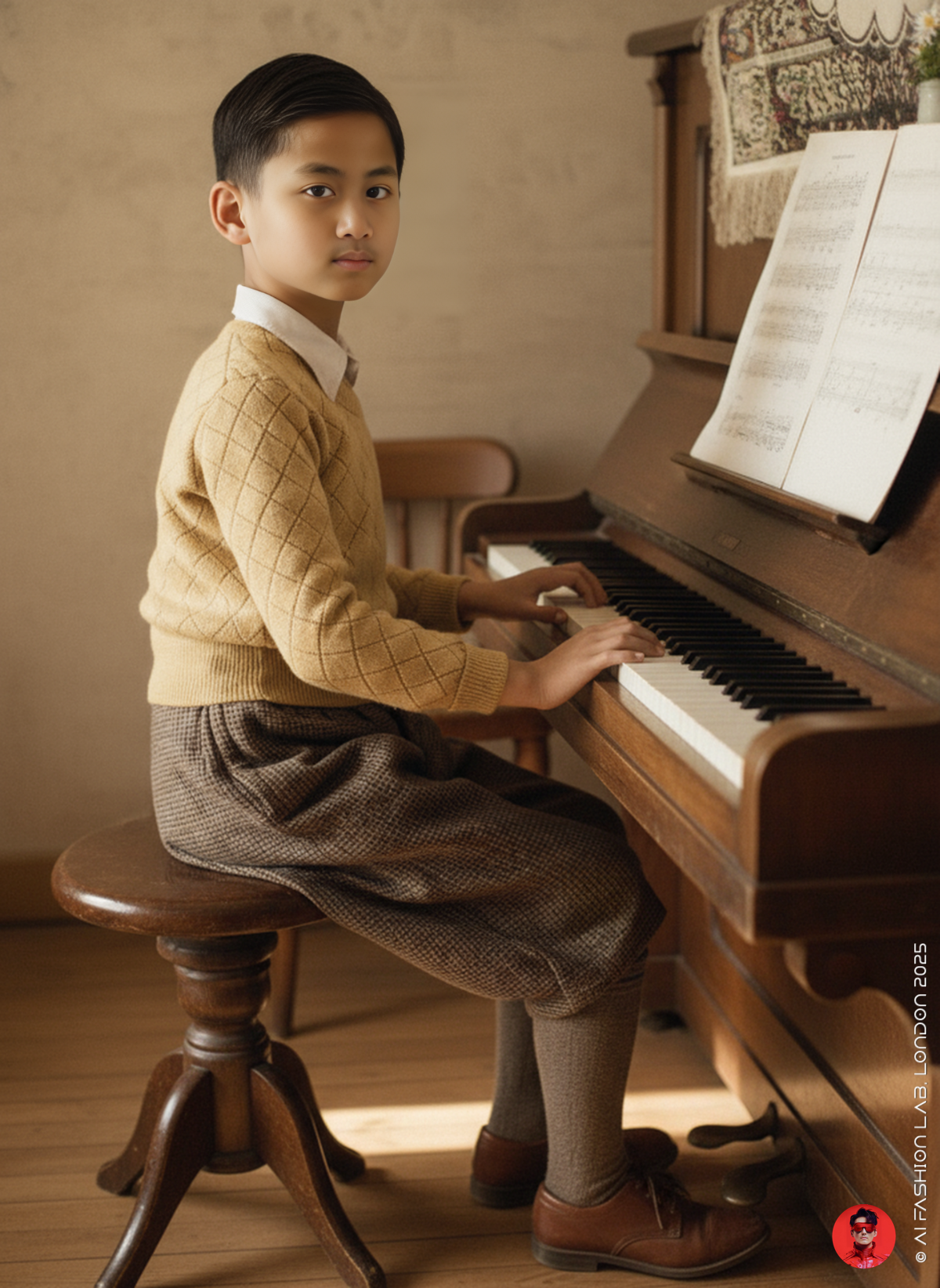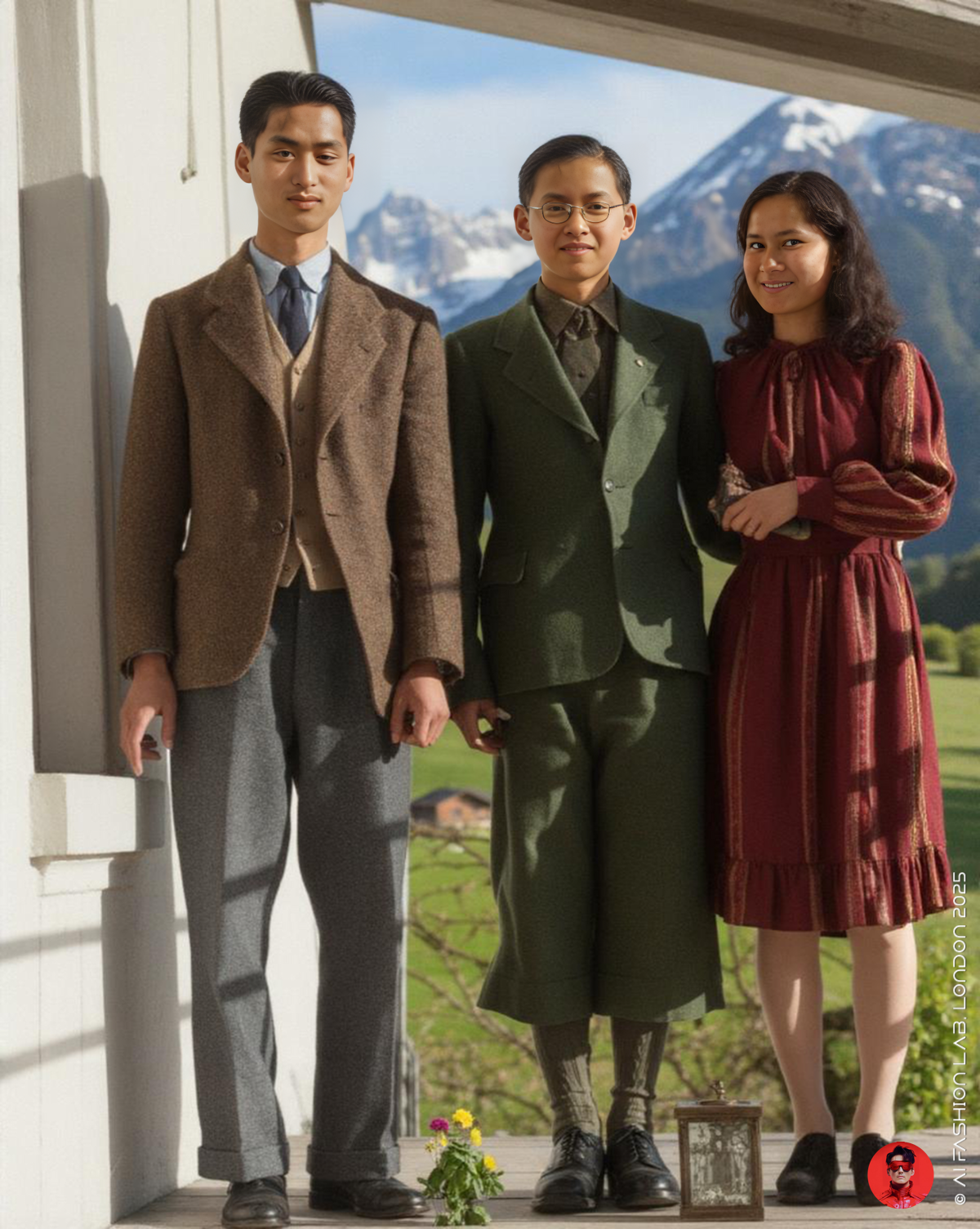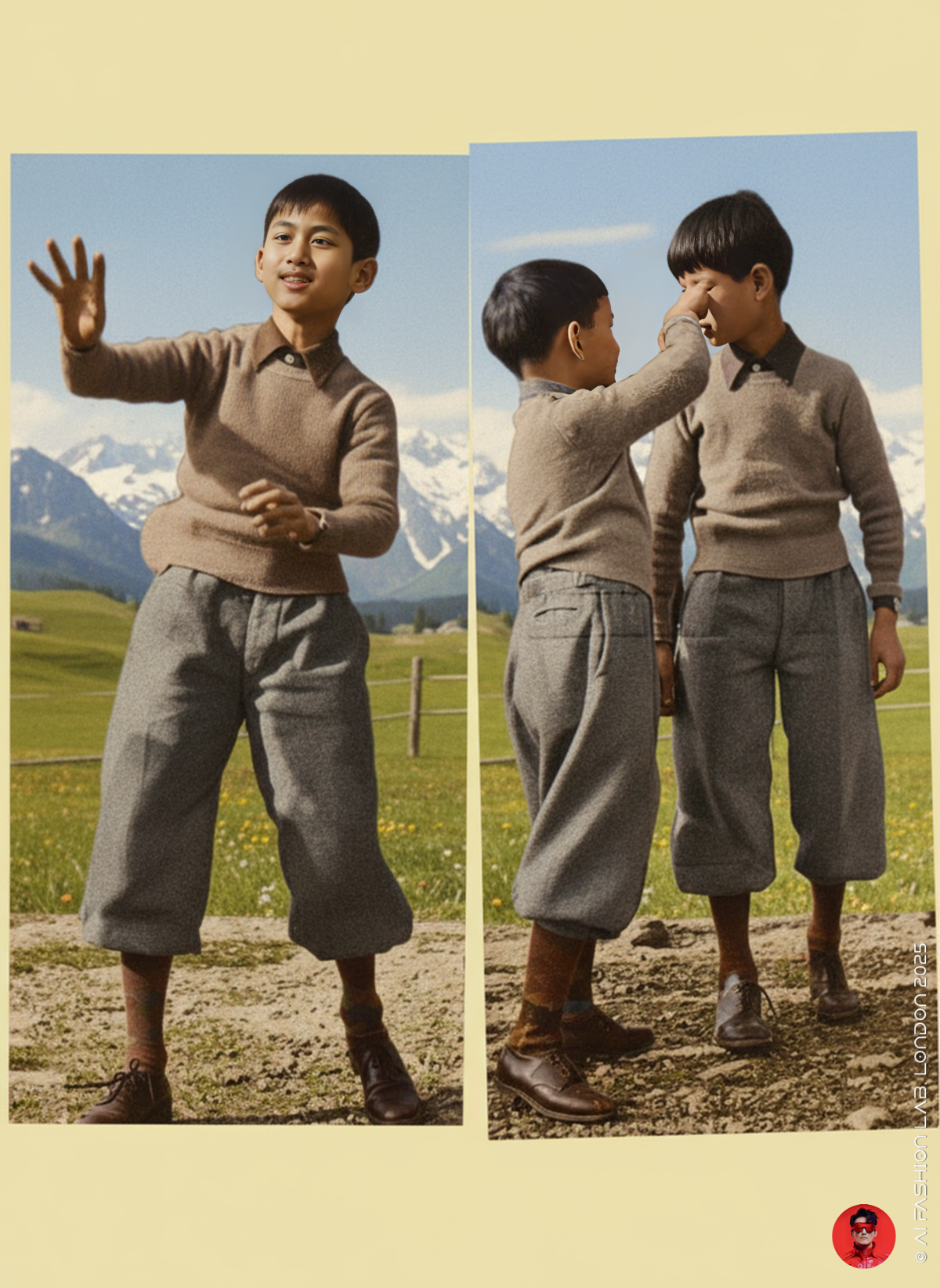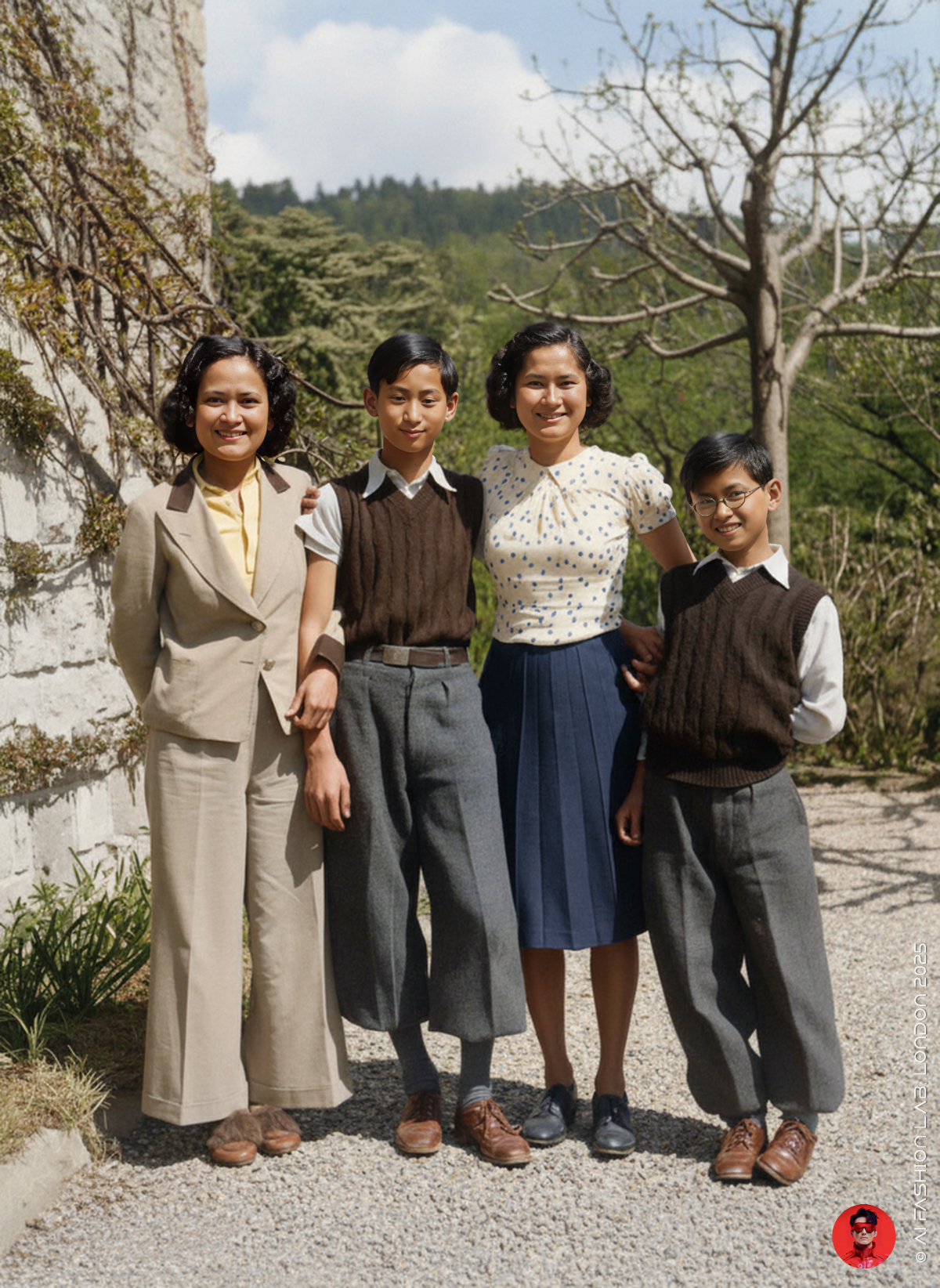แฟชั่นกางเกง “พลัสโฟร์” (Plus Four) ในราชวงศ์ไทยและแฟชั่นโลก
แฟชั่นกางเกง “พลัสโฟร์” (Plus Four) ในราชวงศ์ไทยและแฟชั่นโลก
หลังจากโพสต์ในหัวข้อแฟชั่นกางเกง “พลัสโฟร์” (Plus Four) เมื่อไม่กี่วันก่อน ผมได้ทำการค้นคว้าเพิ่มเติมและบูรณะภาพถ่ายหลายภาพ ภาพที่ผ่านการบูรณะและสร้างสรรค์ด้วยเทคโนโลยี AI เหล่านี้คือพระบรมฉายาลักษณ์ของ พระบาทสมเด็จพระปรเมนทรมหาอานันทมหิดล พระอัฐมรามาธิบดินทร รัชกาลที่ 8 และ พระบาทสมเด็จพระบรมชนกาธิเบศร มหาภูมิพลอดุลยเดชมหาราช บรมนาถบพิตร รัชกาลที่ 9 ในขณะที่ทรงพระเยาว์ ประทับ ณ เมืองโลซานน์ ประเทศสวิตเซอร์แลนด์ พร้อมด้วย สมเด็จพระศรีนครินทราบรมราชชนนี และ สมเด็จพระเจ้าพี่นางเธอ เจ้าฟ้ากัลยาณิวัฒนา กรมหลวงนราธิวาสราชนครินทร์ อีกทั้งหนึ่งในพระบรมฉายาลักษณ์ยังปรากฏ สมเด็จพระเจ้าบรมวงศ์เธอ กรมพระยาชัยนาทนเรนทร อยู่ในภาพด้วย
ทั้งสองพระองค์ทรงฉลองพระองค์ด้วยกางเกง “พลัสโฟร์” ซึ่งเป็นแฟชั่นยอดนิยมในยุคนั้น โดยมี เจ้าชายเอ็ดเวิร์ด เจ้าชายแห่งเวลส์ (ต่อมาคือ สมเด็จพระเจ้าเอ็ดเวิร์ดที่ 8 แห่งสหราชอาณาจักร) เป็นผู้นำกระแสในช่วงทศวรรษ 1920 (ปลายรัชกาลที่ 6) และแพร่หลายทั้งในยุโรปและอเมริกา
แฟชั่นกางเกงพลัสโฟร์ไม่ได้เสื่อมความนิยมไปอย่างรวดเร็ว แต่ยังคงปรากฏต่อเนื่องมาจนถึงทศวรรษ 1930 ดังจะเห็นได้จากพระบรมฉายาลักษณ์ของรัชกาลที่ 8 และรัชกาลที่ 9 ขณะทรงพระเยาว์ ภาพถ่ายเหล่านี้คาดว่าถ่ายขึ้นราว ค.ศ. 1930–1945 (พ.ศ. 2473–2488) และสะท้อนให้เห็นว่าพระบรมวงศ์ชั้นสูงของไทยทรงรับอิทธิพลแฟชั่นสมัยใหม่จากตะวันตกไว้อย่างต่อเนื่อง
อีกหลักฐานสำคัญคือภาพถ่ายในปี ค.ศ. 1922 (พ.ศ. 2465) เมื่อเจ้าชายเอ็ดเวิร์ดเสด็จประพาสตะวันออกไกล โดยเสด็จเยือนญี่ปุ่นและไปยัง Tokyo Golf Club มีภาพถ่ายร่วมกับ มกุฎราชกุมารฮิโรฮิโตะ (ต่อมาคือ จักรพรรดิโชวะ) ทั้งสองพระองค์ทรงสวมกางเกงพลัสโฟร์ในสไตล์สปอร์ตอันทันสมัย การเสด็จเยือนครั้งนั้น ซึ่งรวมถึงอินเดีย เอเชียตะวันออกเฉียงใต้ และญี่ปุ่น มีบทบาทสำคัญในการเผยแพร่ภาพลักษณ์ความเป็นผู้นำแฟชั่นระดับโลกของเจ้าชายเอ็ดเวิร์ด
คำว่า “Plus Four” หมายถึงกางเกงที่ยาวเลยเข่าออกไปสี่นิ้ว แตกต่างจาก Plus Two, Plus Eight และ Knickerbocker ดั้งเดิม กางเกงชนิดนี้ถูกเผยแพร่ในอเมริกาโดยเจ้าชายเอ็ดเวิร์ดระหว่างการเสด็จเยือนทางการทูต ค.ศ. 1924 (พ.ศ. 2467) และกลายเป็นแฟชั่นที่สะท้อนความผ่อนคลายและเสรีภาพแห่งยุคแจ๊ซ กางเกงพลัสโฟร์มักสวมคู่กับถุงเท้าอาร์ไกล์ (argyle socks) เนกไทผ้าไหม เสื้อเชิ้ต เสื้อสเวตเตอร์ หรือแม้แต่สูทเต็มชุด ตัวอย่างเช่น นักดนตรีชื่อดัง หลุยส์ อาร์มสตรอง (Louis Armstrong) เคยสวมใส่เช่นกัน
เดิมทีพลัสโฟร์ถูกออกแบบมาเพื่อการกีฬาและกิจกรรมกลางแจ้ง โดยเป็นส่วนหนึ่งของ Norfolk suit ตัดเย็บด้วยผ้าทวีดหรือผ้าลายตาราง เหมาะกับอากาศหนาวชื้นของอังกฤษ แต่ต่อมาก็กลายเป็นแฟชั่นในตัวเอง ไม่จำกัดเพียงกิจกรรมล่าสัตว์หรือเล่นกีฬาอีกต่อไป
แฟชั่นนี้ยังถูกทำให้เป็นอมตะในวัฒนธรรมสมัยนิยม ผ่านตัวละคร ตินติน (Tintin) ของนักเขียนการ์ตูน แอร์เช่ (Hergé) ซึ่งได้แรงบันดาลใจจาก พาลเล ฮูลด์ (Palle Huld) เด็กหนุ่มชาวเดนมาร์กผู้เดินทางรอบโลกในปี ค.ศ. 1928 (พ.ศ. 2471) เพื่อรำลึกถึงวรรณกรรม Around the World in 80 Days ของ ฌูล เวิร์น (Jules Verne) โดยแต่งกายด้วยพลัสโฟร์ตลอดการเดินทาง
ปัจจุบัน กางเกงพลัสโฟร์ยังคงปรากฏมากที่สุดในวงการกอล์ฟ เป็นสัญลักษณ์ของความสปอร์ตและความรื่นรมย์กลางแจ้ง กางเกงทรงพองและถุงเท้าลายตารางได้กลายเป็นภาพจำของยุคที่แฟชั่นสัมพันธ์กับเสรีภาพ และยังเป็นที่ระลึกถึงช่วงเวลาที่ทั้งเจ้านายฝ่ายตะวันตกและตะวันออก — รวมถึงรัชกาลที่ 8 และรัชกาลที่ 9 เมื่อครั้งทรงพระเยาว์ — ต่างก็ทรงรับเอาสไตล์อันทันสมัยของพลัสโฟร์ไว้เช่นกัน
นอกจากนี้ ยังแสดงให้เห็นว่ากางเกงพลัสโฟร์ไม่ได้ถูกจำกัดอยู่เพียงในอดีต เพราะในโลกแฟชั่นร่วมสมัย Ralph Lauren ได้หยิบกางเกงพลัสโฟร์กลับมาเป็นส่วนหนึ่งของคอลเลกชันสุภาพบุรุษ Spring/Summer 2025 (พ.ศ. 2568) ยืนยันว่ากางเกงชนิดนี้ยังคงเป็นสัญลักษณ์แห่งความคลาสสิกที่ถูกตีความใหม่อยู่เสมอในรันเวย์ระดับโลก
_____________________________
The Fashion of “Plus Four” Trousers in the Thai Royal Family and Global Style
Following my earlier post on the fashion of “Plus Four” trousers a few days ago, I have carried out further research and restored several additional photographs. These AI-restored and enhanced images include royal portraits of His Majesty King Ananda Mahidol (Rama VIII) and His Majesty King Bhumibol Adulyadej the Great (Rama IX) during their childhood years in Lausanne, Switzerland, alongside Her Royal Highness Princess Srinagarindra, the Princess Mother, and Her Royal Highness Princess Galyani Vadhana, Princess of Naradhiwas. In one of these portraits, His Royal Highness Prince Rangsit Prayurasakdi, the Prince of Chainat also appears.
Both young kings are dressed in “Plus Four” trousers, a fashion highly popular at the time, championed by Edward, Prince of Wales (later King Edward VIII of the United Kingdom) who set the trend in the 1920s, during the latter years of King Vajiravudh’s reign (Rama VI). The style quickly spread across Europe and America.
The popularity of Plus Four trousers did not fade quickly, but continued into the 1930s, as seen in the royal portraits of Rama VIII and Rama IX as children. These photographs, believed to date between the 1930s and 1940s (B.E. 2473–2488), illustrate how members of the Thai royal family embraced modern Western fashions.
Another significant example can be traced to 1922 (B.E. 2465), when Edward, Prince of Wales, embarked on a Far Eastern tour, visiting Japan and the Tokyo Golf Club, where he was photographed with Crown Prince Hirohito (later Emperor Shōwa). Both princes wore Plus Fours in a fashionable sporting style. This tour, which also covered India, Southeast Asia, and Japan, played an important role in projecting Edward’s image as a global fashion leader.
The term “Plus Four” refers to trousers that extend four inches below the knee, differing from Plus Twos, Plus Eights, and the original Knickerbockers. Edward helped popularise the style in America during his diplomatic tour of 1924 (B.E. 2467), and it soon became associated with the relaxed, free-spirited Jazz Age. Plus Fours were commonly worn with argyle socks, silk ties, shirts, sweaters, and sometimes even as part of a complete suit — famously adopted by jazz legend Louis Armstrong.
Originally designed for sports and outdoor pursuits, Plus Fours were often paired with the Norfolk suit, tailored in tweed or check fabrics suited to Britain’s damp and chilly climate. Over time, however, they evolved into a fashion statement in their own right, no longer limited to hunting or athletics.
The style was further immortalised in popular culture through the comic character Tintin, created by Hergé, whose inspiration came from Palle Huld, a Danish teenager who travelled around the world in 1928 (B.E. 2471) to commemorate Jules Verne’s Around the World in 80 Days — dressed in Plus Fours throughout his journey.
Today, Plus Four trousers are most often associated with the world of golf, symbolising a blend of sport, leisure, and outdoor enjoyment. Their voluminous cut paired with patterned socks has become emblematic of a period when fashion represented freedom and modernity. They also serve as a reminder of a moment in history when both Eastern and Western royalty — including Rama VIII and Rama IX in their youth — embraced this stylish innovation.
Moreover, Plus Fours have not remained confined to the past. In contemporary fashion, Ralph Lauren reintroduced them as part of his Spring/Summer 2025 menswear collection, affirming that this garment continues to embody timeless classicism while being continually reinterpreted on the global runway.
#aifashionlab #AI #aiartist #aiart #aifashion #aifashiondesign #aifashionstyling #aifashiondesigner #fashion #fashionhistory #historyoffashion #fashionstyling #fashionphotography #digitalfashiondesign #digitalcostumedesign #digitaldesign #digitalaiart #ThaiFashionHistory #ThaiFashionAI #thailand














